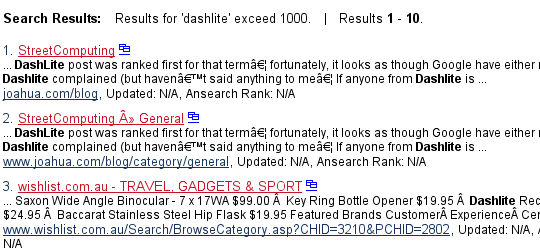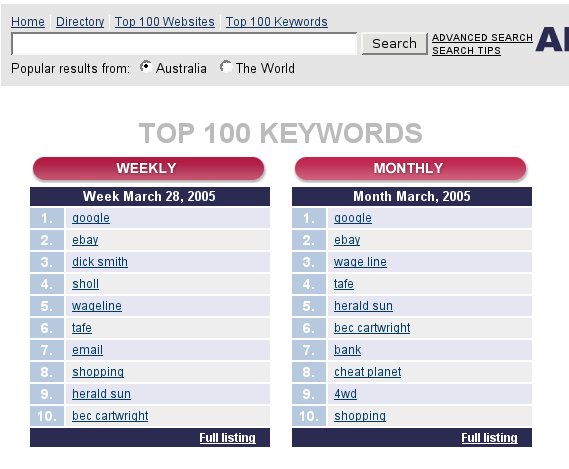Something about backwards search engines
04 Apr 2005No, I’m not talking about elgooG.
The Sydney Morning Herald published an article entitled “New Australian search engine launched” today, the first paragraph of which reads “Australia’s newest search engine Ansearch opens for business today with a novel twist, demographic searching.” It’s not a particularly well written article, but the article vendor is AAP, not the SMH itself, so we’ll leave that alone, at least for the minute.
It goes on to laud the search engine for their innovation, both in this feature of demographic searching, and in other areas:
Ansearch says it cuts down search clutter by displaying the main search results as single websites and not the individual pages of websites.
What, like the Google [More results from domainname] feature? You know, the one that actually works properly? I say “works properly”, because a quick search of Ansearch reveals that their “cutting search clutter” feature is a tad broken — not to mention their character encoding.

Speaking of broken character encoding, let’s take a look at their source… well, they get some marks — at least they bothered with a Content-Type. Never mind if the content is broken when displayed with that Content-Type — it’s not like a search engine could actually do any useful data processing to make things display correctly when using a slightly redundant Content-Type… oh, wait, disregard that comment: they’re not using a doctype, either.
See, what gets me is that this search engine has just been launched. Which means the climate in which it’s been developed isn’t the same as 5 years ago, when accessibility was just on the very edges of the radar — you’d (wishfully) imagine that at least a doctype wouldn’t be too much to ask for, even if they still insisted on using table-based layouts. Interestingly enough, that’s what one of their software providers, Omniture, have done. Which leaves something of a foul taste in the mouth, too, because they’re reselling that garbage to people — including, if you believe their website, three of the five top Fortune 500 companies (aside: doesn’t that make them three of the top Fortune 5?).
Perhaps that criticism is unfair — their latest version (assuming that’s what powers their own website, although possibly not… maybe their internal web team accepts that their product would be overkill, and coded it in Dreamweaver, instead… some of the JavaScript certainly looks Dreamweaver-esque, and, if Ansearch’s website is any example, the doctype probably doesn’t come from the Overture system!) seems to handle much better than what Ansearch are running: I say this, because apparently they’re using a version which was written back in 2003. Hey, if it works… but we’ve already established it doesn’t.
And there concludes my rave review of yet another quite-some-way-from innovative and fresh search engine, this time in Australian waters.
Note: I’m not saying it’s any worse in terms of accessibility, usability, and semantics than most other search engines are — only that it has less excuse, being launched now, as opposed to 5 or 10 years ago. It’s easier to make something work first time than it is to haphazardly patch over it later, especially something as gargantuan as I’d imagine a search engine would be.
Oh, and now for something that’s just plain amusing — the number 1 search terms on this brand new search engine, from befuddled users wondering why it sucks so much:

Yes indeed, the first thing users did was try to escape… how’s that for telling?